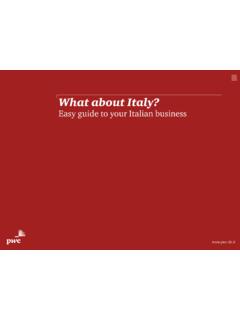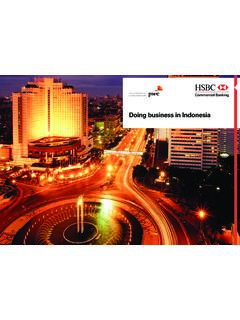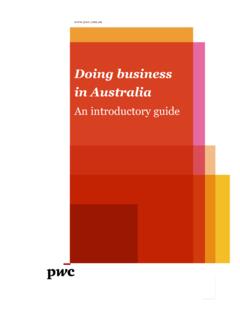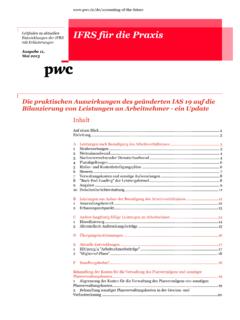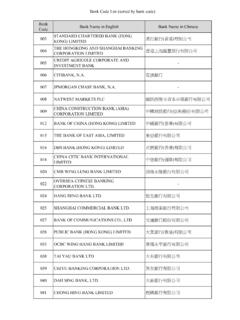Transcription of Doing business in India - PwC
1 This publication is a joint project withDoing business in IndiaExecutive summary 4 Foreword 6 Introduction Doing business in India 8 Conducting business in India 18 Taxation in India 20 Audit and accountancy 28 Human Resources and Employment Law 29 Trade 30 Banking in India 31 HSBC in India 32 Country overview 36 Contacts 38 DisclaimerThis document is issued by hongkong and Shanghai Banking Corporation limited , India Incorporated in hong kong SAR with limited Liability in partnership with PricewaterhouseCoopers (PwC). It is not intended as an offer or solicitation for business to anyone in any jurisdiction. It is not intended for distribution to anyone located in or resident in jurisdictions which restrict the distribution of this document. It shall not be copied, reproduced, transmitted or further distributed by any information contained in this document is of a general nature only.
2 It is not meant to be comprehensive and does not constitute financial, legal, tax or other professional advice. You should not act upon the information contained in this publication without obtaining specific professional advice. This document is produced by the Bank together with PricewaterhouseCoopers ( PwC ). Whilst every care has been taken in preparing this document, neither the Bank nor PwC makes any guarantee, representation or warranty (express or implied) as to its accuracy or completeness, and under no circumstances will the Bank or PwC be liable for any loss caused by reliance on any opinion or statement made in this document. Except as specifically indicated, the expressions of opinion are those of the Bank and/or PwC only and are subject to change without notice. This document is not a Financial Promotion.
3 The materials contained in this publication were assembled in July 2012 and were based on the law enforceable and information available at that of the Indian regulatory framework has enhanced its attractiveness as a destination for foreign investors. This guide sets out some of the key issues that foreign investors should consider when establishing their operations in aspects of Doing business in India :GrowthIndia is the world s largest democracy and the second-fastest growing major and stable governmentIndia offers political stability that is vital to foreign investments. Government agencies, which have a pro- business attitude, work closely with the business sector to promote economic trade linksInvestors can leverage on India s trade network with its regional and bilateral free trade agreements with many trading partners.
4 Increasing infrastructure and good living standardsA significant investment in infrastructure is taking place in India , particularly in the metropolitan areas. Coupled with this, India offers good living standards with a robust transport system, superior healthcare facilities and first-class entertainment tax systemIndia offers a very competitive tax regime and comprehensive network of Tax Treaties. Indian taxes would be further modified by the introduction of Direct Taxes Code (which was expected to be introduced in April 2012 but has been delayed) and the Goods and Service workforceIndia offers a highly-rated human capital base recognised for its skills, knowledge and financial systemIts financial system is well regulated and offers a broad range of services. Businesses can also tap into its developed capital markets as an alternative source of financing.
5 Robust legal systemThe legal and judicial system here is robust and efficient, thus, businesses can count on India s rigorous enforcement of laws. Great work ethicsIndia has great work ethics and a very professional way of operating. Employees are hard working and willing to work on holidays/weekends if summary6 Foreword* Economic Times report quoting IMF data ( ) ** ** today s world, business must compete on a much wider playing field, no longer confined within national liberalisation in 1991, India has undergone a paradigm shift owing to its competitive stand in the world. The Indian economy has been on a growth trajectory over the last decade with rapid strides across new age industries like Information Technology, IT enabled services, and Pharma to name a few. Today, India is the third largest economy in the world by GDP PPP (purchasing power parity)*, seventh largest country in the world by area and second largest by population** and there is ample reason for India s viability as a destination for foreign investment.
6 In addition to the above-mentioned macroeconomic indicators, higher disposable incomes, emerging middle class, low cost but competitive and skilled workforce, all contribute towards India being an appropriate choice for India , the antecedents of the HSBC Group can be traced back to setting up of the Mercantile Bank in 1853. HSBC, with over 150 year s expertise, offers the full range of banking and financial services to customers across 29 major Indian cities and backed by our global presence in 84 countries and territories with around 6,900 offices worldwide**. We are well positioned to assist entrepreneurs, multinationals and conglomerates eager to tap into this exciting and booming in collaboration with PricewaterhouseCoopers, this guidebook, Doing business in India , provides a thorough analysis of various options in establishing a business in India .
7 It also provides an insight into key opportunities available in India , as well as taxation systems and laws applicable to businesses operating your trusted partner, HSBC is always looking for ways to facilitate your business growth. With this guide, I hope you find the impetus for building a successful venture in India and I wish you a very prosperous future in this land of Milne CEOHSBC India8 Economic Growth The growth of the Indian economy is based upon rapid urbanisation, poverty alleviation and building much-needed infrastructure. This creates significant opportunities for foreign investment. In addition to this, India is now Asia s biggest buying economy, and has the world s largest growing middle class. The 2011 PwC report, Profitable growth strategies for the Global Emerging Middle (GEM) estimated that by 2021, India will have about 600 million people constituting its emerging middle class segment.
8 According to the Economic Survey 2011-12, the Indian economy is estimated to grow at per cent in 2011-12 and per cent in 2012-2013. The growth forecast has broadly been based on the rebound in the agriculture sector which is expected to grow around per cent. The Index of Industrial Production (IIP) registered a robust growth of per cent in January 2012. Output of the manufacturing sector (which constitutes over 75 per cent of the index) grew by per cent while the mining sector and electricity sector increased by per cent and per cent respectively. Industrial production expanded by 4 per cent between April 2011-January 2012. In light of the economic uncertainties in Europe, although the Indian economy has slowed down recently, opportunities still exist for significant growth.
9 The biggest problem in India has been inflation which was averaging at in 2011. With monetary tightening and slowing growth, inflation is expected to plateau to 8% this year and in 2013. The Asian Development Bank has estimated that over the next two decades, the middle-class population in the country will reach 1 billion. Since 2001, the Indian middle-class has seen increases in its disposable income, and consequently, consumption and savings have also risen. With the current rate of growth, analysts predict that by 2025, India will become the fifth largest consumer goods market in the world and the Indian middle-class is set to assume the traditional role of the American and European middle-classes. This view has also been acknowledged by the Global industry in particular. With an enhanced consumer segment in terms of increased consumption in consumer durables furthering growth, and a positive outlook on employment and rising incomes, this has facilitated growth in consumption.
10 India s performance has been widely acknowledged by global agencies: IntroductionDoing business in India India is ranked as the second most favoured destination for FDI over 2010 -12 ( World Investment Prospects Survey 2010-2012, UNCTAD). India is the world s top location for non-financial services investment and among the top three most attractive international investment destinations (AT Kearney 2010 FDI Confidence Index). India ranked among the top three countries where British companies can do better business during 2012-14 (Report by Leeds University business School commissioned by UK Trade & Investment (UKTI). Offers great promise as a vital and high-potential market, securing the top ranking in both the AT Kearney s 2009 Global Retail Development Index and the 2009 Global Services Location Demographic advantage India is today one of the three largest Asian economies in terms of purchasing power parity.)






